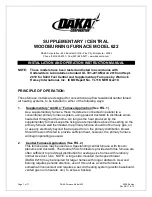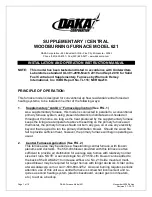
27
Problem: Down draft on chimney caused by one or more of the following.
Possible Causes:
Remedies:
• Flue has a cold spot which
inhibits exhaust discharge from
rising properly.
• This problem may occur in factory built flues because the insulation
has settled or a seam has ruptured. In masonry flues, mortar loss
may be causing seepage of cooler outside air into the stack. Check
entire flue for structural integrity and leakage. Correct or repair as
needed, or replace or re-line the chimney.
• Remove obstruction.
• Increase chimney height.
• Increase chimney height.
• There is an obstruction outside
chimney, such as a tree.
• Flue is located too close to the
peak of the roof or does not rise
above it to provide the proper
draft.
• Flue is too close to another
building.
16.
• Check entire chimney system including stove pipe run. Utilize
chimney cleaning device to remove any obstruction or foreign
matter.
• Remove as necessary.
• Obstruction in chimney.
• Excessive ash accumulation.
Problem: Flames discharging from fuel door during reloading.
• Opening the door has provided
additional oxygen which has
ignited the accumulated gases
from partially spent fuel.
• Always open the door cautiously and allow the safety latch system
to perform its designed function, containing gases within the fire
chamber.
Possible Causes:
Remedies:
17.
• Insufficient natural draft or an
obstruction in the flue system.
• See #8, #9 and #16.
• Fire chamber filled to capacity
with unburned fuel.
• Do not attempt to overload the furnace.
Problem: The air coming out of heat registers is not warm enough.
Possible Causes:
Remedies:
18.
• The chimney on the furnace is
not tall enough which is affecting
the efficiency of the furnace.
• Add additional sections of chimney to the flue to ensure compliance
with the “10/2 Rule.” See diagram on page 7.
• Wood being used is not dry
enough to produce higher BTU’s.
• Use hardwood that is covered and protected from the weather for at
least a year. Avoid using rotten or poor quality wood.
• Outside air is being pulled
through the return air duct, thus
reducing the temperature of the
heat supply.
• Check the return duct and blower housing for holes and cracks, and
seal with aluminum tape.
• Fan limit control is not set to
factory specifications.
• Set fan limit to 160° as high limit, and 100° as the low limit.
Summary of Contents for SF3048
Page 30: ......































